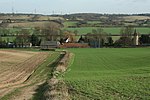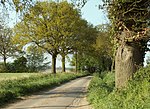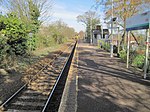Alphamstone

Alphamstone is a village and civil parish in Essex, England. It is located 3+3⁄4 miles (6.0 km) south of Sudbury in Suffolk and is 20 mi (32 km) northeast from the county town of Chelmsford. The village is in the district of Braintree and in the parliamentary constituency of Braintree. The parish is part of the Stour Valley South parish cluster. The parish is 1,709 acres (2.67 sq mi; 692 ha) with a geology of fertile clay-soils, and is at an elevation of 216 feet (66 m) above sea level. The population is included in the civil parish of Lamarsh. The village is a mile west of the River Stour, which forms the Essex-Suffolk county-border in the local area. The village has one parish church, the C of E St Barnabas. It was built in the thirteenth century and went through restorations in the 16th and 19th centuries. The churchyard also features seven sarsen stones, potentially once a prehistoric stone circle. In 1831 the population of the village was 244 inhabitants. It is about 2 miles (3.2 km) from the nearest railway station at Bures on the Sudbury Branch Line. Its nearest significant road link is the A131.
Excerpt from the Wikipedia article Alphamstone (License: CC BY-SA 3.0, Authors, Images).Alphamstone
Lamarsh Road, Essex
Geographical coordinates (GPS) Address Nearby Places Show on map
Geographical coordinates (GPS)
| Latitude | Longitude |
|---|---|
| N 51.989 ° | E 0.7428 ° |
Address
Lamarsh Road
Lamarsh Road
CO8 5HR Essex, Alphamstone
England, United Kingdom
Open on Google Maps








